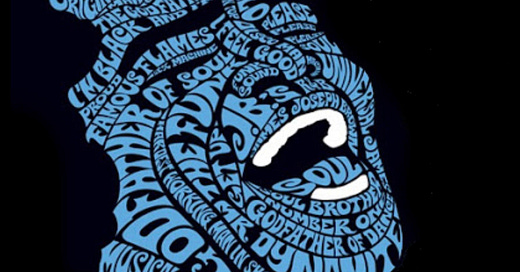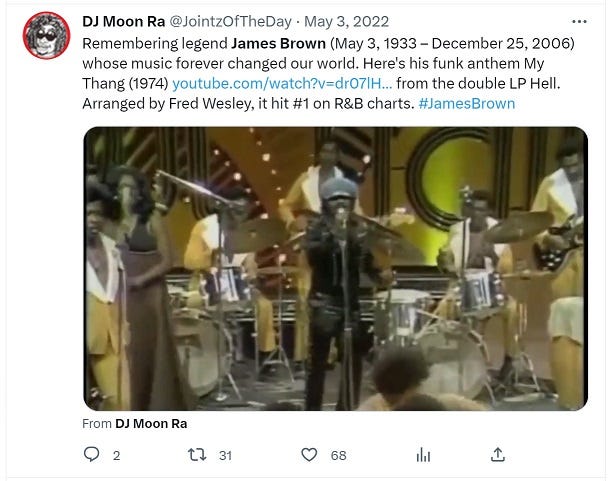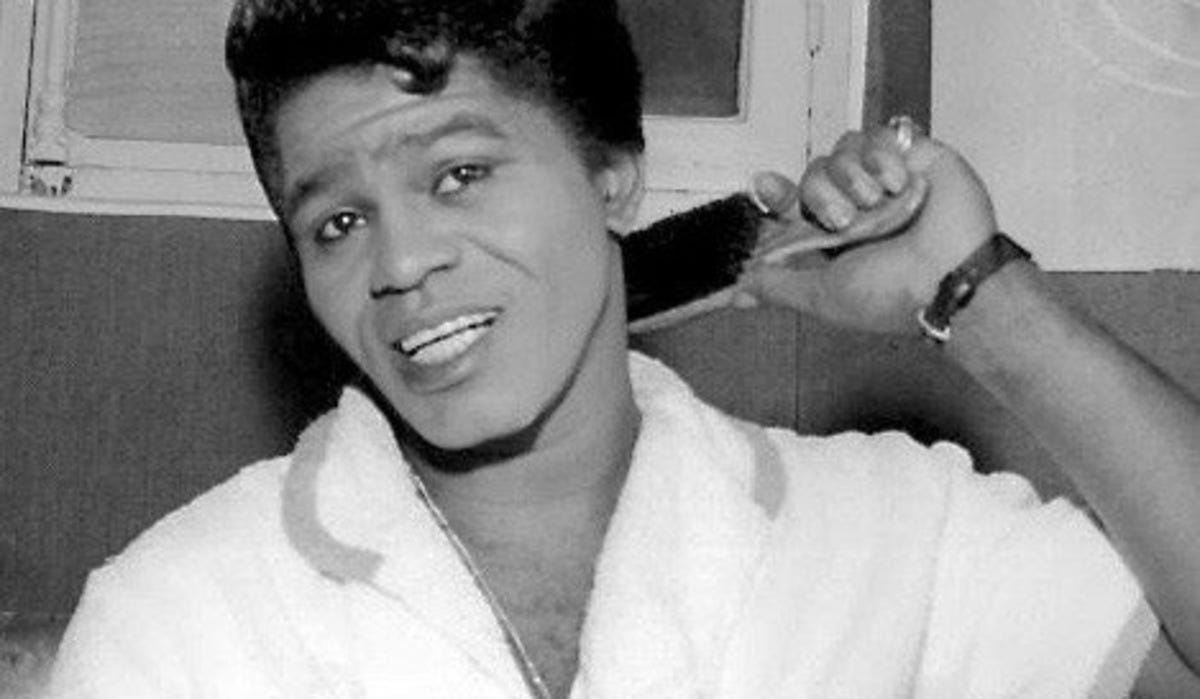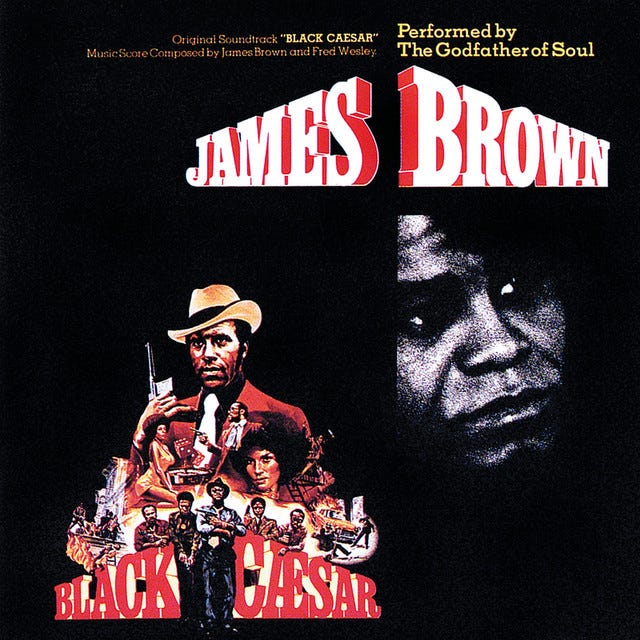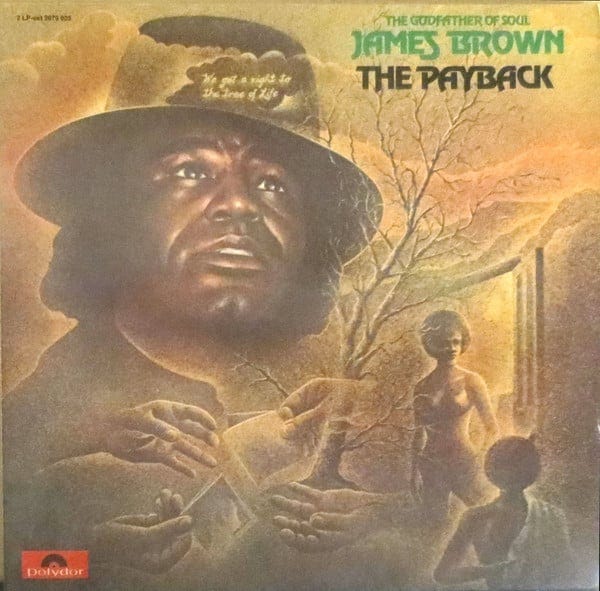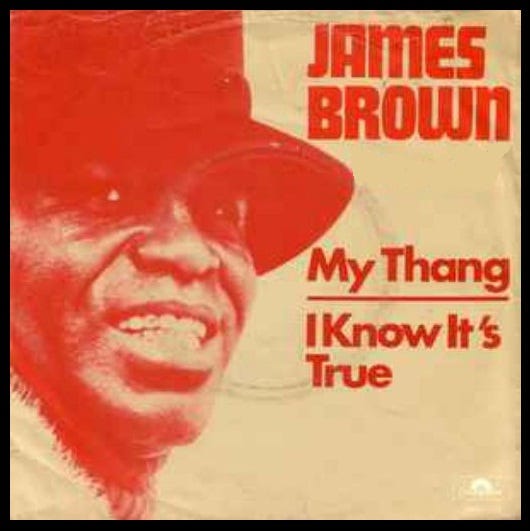James Brown (May 3, 1933 – December 25, 2006) – My Thang (1974)
On what would have been the Godfather of Soul's 90th birthday, remembering the funk bomb he wrote, produced, and took to #1 R&B in the summer of '74.
Watch full video on YouTube.
James Brown (aka The Godfather of Soul, Soul Brother #1, and the Minister of New New Super Heavy Funk) was one of the most influential musicians of the twentieth century who helped bring funk to life and whose sound forever changed our world.
James Joseph Brown was born into extreme poverty in a small wooden shack in Barnwell, South Carolina. His family moved to Augusta, Georgia when he was a young child, initially living in a brothel owned by one of his aunts. Brown won his first talent show at age 11, appearing on stage at the Lenox Theater in Augusta in 1944. He learned to play the guitar, piano and harmonica in his early teens.
A robbery conviction at age 16 might have derailed his musical ambitions, but when Brown was sent to juvenile detention, he formed a gospel quarter with his cellmates. He met Bobby Byrd when they were on opposing teams in a baseball game held away from the detention center. Byrd’s family helped secure an early release for Brown, and once paroled he joined a gospel group alongside Byrd’s sister Sarah, the Ever-Ready Gospel Singers.
Byrd formed his own a cappella gospel group called the Gospel Starlighters, which evolved into the Avons, an R&B outfit. Brown joined in 1954, and after several more name changes the group eventually became the Famous Flames.
Their debut single was “Please, Please, Please,” a title derived from words Little Richard wrote on a napkin when the group met him while performing in Macon, Georgia in 1955. Brown put his mind to making it a song, and the result was released in March, 1956 on Federal, a King Records subsidiary. It became a #6 R&B hit, sold over a million copies, and launched the group’s rise to stardom.
For more on Brown’s lengthy career, see the excellent biography The One: The Life and Music of James Brown, by R.J. Smith, published in March, 2012, and reviewed by Jeff Dayton-Johnson for All About Jazz.
In 1973 Brown composed his first soundtrack, for Larry Cohen’s Blaxploitation film Black Caesar. It was the first in a pair of movies about fictional Black gangster Tommy Gibbs, played by Fred Williamson. Brown produced the album and co-arranged it with his J.B.’s bandleader Fred Wesley. Highlights included the superb opening cut “Down And Out In New York City,” the funky jam “Mama Feelgood” featuring Lyn Collins (who co-wrote the song with Brown), and the smooth strutting anthem “The Boss,” which he co-wrote with Charles Bobbitt and Wesley.
Brown followed up Black Caesar with another soundtrack, for Slaughter's Big Rip-Off (1973), starring Jim Brown and Gloria Hendry. He was also supposed to do the soundtrack for Black Caesar’s sequel, Hell Up In Harlem (1973). But according to director Cohen, executives at the film studio American International Pictures were already unhappy with Brown because the tracks he composed for Black Caesar and Slaughter's Big Rip-Off were much longer than expected, and struck a deal with Motown instead. The Hell Up In Harlem soundtrack was recorded by Edwin Starr.
The songs Brown had intended for the soundtrack were released in December, 1973 as The Payback LP, which became his all time best-selling studio album. It spent two weeks at #1 R&B, crossed over to the Top 40 on the Billboard Hot 100, and went gold. The Payback’s lead single “Stoned to the Bone (Pts. 1 & 2)” was released in advance of the album in November, 1973 and went to #4 R&B.
In the wake of The Payback's success, Brown planned the ambitious double album Hell (1974) as his next studio project.
On November 27, 1973, Brown and his backing band entered A&R Studios in New York City to begin recording the ultra-funky track “My Thang,” which would end up on Hell. Additional recording was completed from March - April 1974 at another New York studio, Sound Ideas. Wesley arranged the track, and Brown wrote and produced it.
The backing band on “My Thang” included J.B's members Wesley on tambourine and backing vocals, Alfred "Pee Wee" Ellis on baritone sax, and Bobby Roach (who usually played guitar) on backing vocals, plus Dave Matthews on piano, who was one of Brown's arrangers and bandleaders. Once released in April, 1974, the single went to #1 R&B. Unlike most of Brown’s singles, with a Part 1 and 2 on each side, “My Thang” was issued with three different B-sides (“People Get Up And Drive Your Funky Soul,” “I Know It's True," and the heartfelt, masterpiece message song “Public Enemy No. 1 - Part I.”)
“My Thang” also included a stellar cast of top session musicians like Michael Gipson on trombone, Frank Vicari on tenor sax, Sue Evans on percussion and Jimmy Madison on drums. Special guests included David Sanborn on alto sax, Joe Farrell on tenor sax, and Joe Beck on guitar. Also featured were bassist Gordon Edwards, one of the founding members of the jazz-funk group Stuff, and Jon Faddis on trumpet (a former sideman to Charles Mingus and Lionel Hampton).
The completed Hell double album was released on June 28, 1974. See our post from March on “Coldblooded,” its superb third and final single, for more on Hell.
Happy Heavenly 90th Birthday to the Godfather!
Further info:
The One: The Life and Music of James Brown, by R.J. Smith, 2012
“RJ Smith: The One - The Life And Music Of James Brown,” Book Review By Jeff Dayton-Johnson, All About Jazz, June 26, 2012
“James Brown: A Life In Photos,” Wax Poetics, December 22, 2021
#funk #soul #FredWesley #BobbyByrd #JamesBrown


